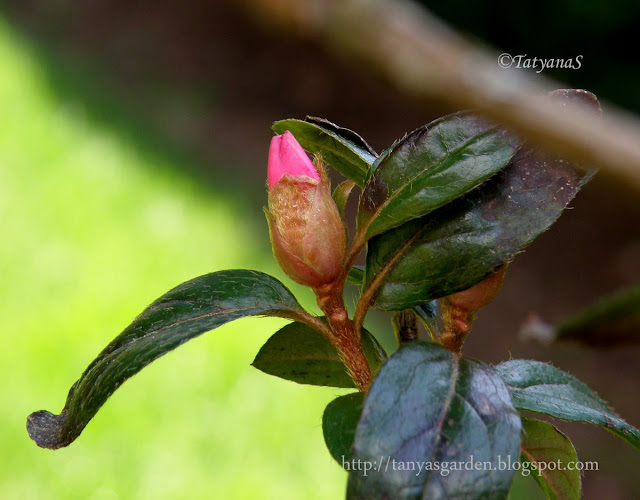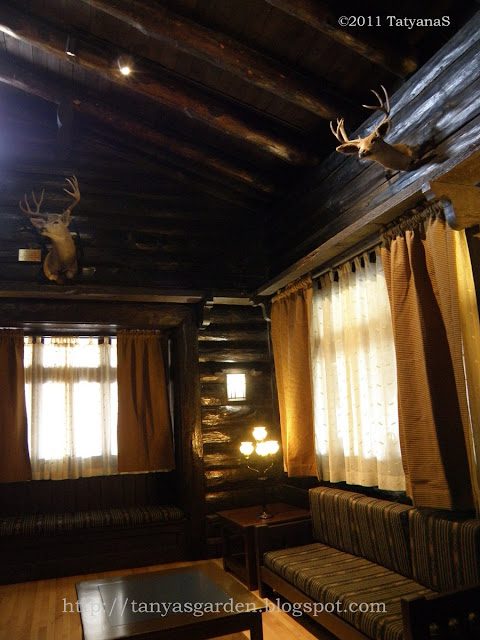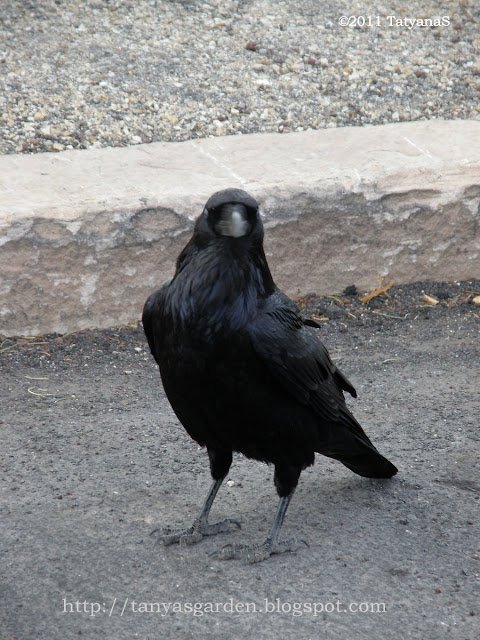***
Copyright 2011 TatyanaS
Tulips Galore. Part 1
We are so fortunate to be able to visit the annual Tulip Festival in the Skagit Valley in Washington state! This year, it was held for the 28th time. Multicolorful fields of tulips are mesmerizing!

To see more varieties, we visited the RoozenGaarde display garden (3.5 acres filled with almost a quarter of a million of spring-flowering bulbs).
Where else to enjoy the tulips if not in the garden of the largest tulip bulb grower in the U.S.! By the way, the Roozen family business is the largest in the world in growing tulips, irises and daffodils.
What struck me the most was the variety: the mix of colors, forms, shapes and sizes.
Cup-, bowl-, goblet-, star-shaped... Single and double...
One-color and multi-colored...
Clicking on the pictures will make them BIG
Subdued in color and bright and bold...
Highlighted by the sun and glowing...
Tulip razmataz...
Pure, innocently white:
I loved these flowers a lot:
especially when they were blown by the wind:
These stars made me smile:
What a contrast with classic cup-like blooms!
Aren't they a bit childish?
The orange color is not among my favorites, I liked these:
I also liked the lemon-yellow color on the top of the next picture:
And, again, the fields:
The old, moss-covered building looks great in such a surrounding:
One thousand acres of blooming fields belong to the RoozenGaarde company, but there are others... The scene is unbelievably beautiful. 

Add the mountains, some of them snow-capped.... Spectacular!
The next photo is one of my favorites from this trip.
To see the names of the tulips, go to the RoozenGaarde catalogue.
Enjoy!
To be continued with more pictures.
My previous years' posts about this Festival:
***Copyright 2011 TatyanaS
Labels:
Gardens to see,
Tulip Festival,
WA
April Buds and Blooms
Azalea
Euphorbia
Saxifrage
Bluebell
Helleborus
Astilbe
Solomon Seal
Peony
Trillium
Viburnum
Rock Cress
***Copyright 2011 TatyanaS
Labels:
Spring/Summer garden
Shade Garden Duet
My small and relatively young shade garden is awakening. These are two of my favorites.
The species is named in honor of a Japanese botanist, Masataka Kurabayashi, who specialized in Trillium. Plants have slightly mottled leaves and robust, broad petalled, upright flowers of deep purple-red color, which are considered to be among the best of the stemless species.
I hope this plant can spread in my garden too!
Credit: A-Z Encyclopedia of Garden Plants
***Copyright 2011 TatyanaS
 | |||||
| Brunnera macrophylla 'Jack Frost' Named for the Swiss botanist Samuel Brunner (1790-1844). Common name - Siberian Bugloss. True blue flowers resemble those of Forget-me-not. This is where its other name comes from: False Forget-me-not. I find Brunnera's flowers striking. Their color reminds me of a Blue Poppy. Alternate leaves help to catch light in a shady spot. They are attractive in several regards: heart shape, silvery color, green veins. Very showy! What is interesting about them is that I can almost see them getting bigger. What attracts me to this plant: easy to grow, low maintenance, cold hardy, both shade and sun tolerant, long bloom, color of flowers is rare, both foliage and flowers are pretty, deer resistant, no pests. I hope it will spread in my garden! General information:
Credits: The New Perennial club |
 |
| Trillium kurabayashi 'Giant Red' Common name - Giant purple wakerobin |
I hope this plant can spread in my garden too!
Credit: A-Z Encyclopedia of Garden Plants
***Copyright 2011 TatyanaS
Oh-la-la!
Recently, I attended a meeting with our famous and much-loved Northwest garden guru Ciscoe Morris. There are many garden gurus of course. Ciscoe is not only knowledgeable and experienced, but very-very entertaining. We love him! Here are just several of his tips that I need to follow in my garden.
1. Dandelions - to eliminate, apply undiluted vinegar. Use only on hot sunny days. Overseed the spot when a dandelion dies (amen).
2. Tulips in containers. After flowers are wilted, remove only a spent bloom, not a stem. Let stem and foliage die, then dig out and store bulbs, replant in spring.
3. Unwanted blackberry bushes: Mow. Mow. Mow. Bushes will get exhausted, tired and die.
4. Hellebore. Don't forget to remove ugly dark leaves in winter.
5. Slugs. Use only Sluggo. Safe.
6. Euphorbia. Be careful working with it. Harmful for skin and eyes.
7. What makes a garden great? Contrast!
8. What to do with winter-exhausted, long-legged Heuchera? Cut back to an 1/8 inch above the ground. Try to plant cuttings, it can work!
9. Prune Japanese maples in June (not in spring as I did).
10. Slugs don't eat dry pellets. If it's too dry outside, wet the pellets.
There were many other subjects discussed. For example:
-How did all these snails get to the state of Washington (from France, of course!);
-What are the easiest vegetables to grow (broccoli, lettuce, etc.);
-What disease resistant helleborus to plant (try Pink Frost);
-What plant will chase a deer away (try Fritillaria imperialis);
-What shrubs does Ciscoe love? (One of his favorites - Grevillea victoriae from Australia, it blooms all winter!);
-For better pollination, plant a California lilac near a vegetable garden.
Want to know what I liked the most in Ciscoe's presentation? Attention, all the Pacific Northwest gardeners! Are you tired from the rain? Are you soaked and depressed? It 'll make you feel better! Here it is: We have a Mediterranian climate here!
I want to read his book Ask Ciscoe: Oh, la, la! Your Gardening Questions Answered , especially after he told that reading it for 15-minutes will help you to fall asleep. This is what I need!
Oh-la-la! - is Ciscoe's signature expression. He told us a hillarious story about how it became his favorite. But, I won't retell it here out of respect for his right to tell this story. So, if you are curious, attend a meeting with him if he is in your area.
*** Copyright 2011 TatyanaS
1. Dandelions - to eliminate, apply undiluted vinegar. Use only on hot sunny days. Overseed the spot when a dandelion dies (amen).
2. Tulips in containers. After flowers are wilted, remove only a spent bloom, not a stem. Let stem and foliage die, then dig out and store bulbs, replant in spring.
3. Unwanted blackberry bushes: Mow. Mow. Mow. Bushes will get exhausted, tired and die.
4. Hellebore. Don't forget to remove ugly dark leaves in winter.
5. Slugs. Use only Sluggo. Safe.
6. Euphorbia. Be careful working with it. Harmful for skin and eyes.
7. What makes a garden great? Contrast!
8. What to do with winter-exhausted, long-legged Heuchera? Cut back to an 1/8 inch above the ground. Try to plant cuttings, it can work!
9. Prune Japanese maples in June (not in spring as I did).
10. Slugs don't eat dry pellets. If it's too dry outside, wet the pellets.
There were many other subjects discussed. For example:
-How did all these snails get to the state of Washington (from France, of course!);
-What are the easiest vegetables to grow (broccoli, lettuce, etc.);
-What disease resistant helleborus to plant (try Pink Frost);
 |
| photo: Hort Printers |
 |
| Fritillaria imperialis. Photo Wikipedia, by Sir James |
 |
| Grevillea. Photo: The Desert Northwest |
 |
| Blooming California lilac in my June garden |
I want to read his book Ask Ciscoe: Oh, la, la! Your Gardening Questions Answered , especially after he told that reading it for 15-minutes will help you to fall asleep. This is what I need!
Oh-la-la! - is Ciscoe's signature expression. He told us a hillarious story about how it became his favorite. But, I won't retell it here out of respect for his right to tell this story. So, if you are curious, attend a meeting with him if he is in your area.
*** Copyright 2011 TatyanaS
Labels:
Garden works,
Gardening Tips,
Hellebores,
WA
Trees I Met at the Grand Canyon
According to the National Park Service, there are approximately 200 species of trees and shrubs in the Grand Canyon National Park. 
Some of the tree species include white fir, Engleman spruce, blue spruce, Douglas fir, corkbark fir, ponderosa pine, Utah juniper, alligator juniper, Colorado pinyon, quaking aspen, Fremont cottonwood, Gambel oak, and Arizona walnut.
All pictures can be enlarged by clicking
While the magnificent canyon itself awoke thoughts about eternity and the power of nature, its trees made me think about strength, resistence and the will to live.Some of the trees are hundreds of years old and could tell a lot about their visitors. Most of all, I would love to see the faces of those people who came here long ago and knew nothing about the canyon's existence. We, modern people, are at least to some extent prepared for meeting this phenomen thanks to the media. Books, movies, photographs... But what about those travelers who just stumbled upon this humongous crack in the earth's body?
By the way, do you know that the Grand Canyon is not the deepest canyon in the world? The deepest one is the Colca Canyon in southern Peru (Wikipedia). It is more than twice as deep as the Grand Canyon, although its walls are not as vertical as those of the Grand Canyon. The Colca Canyon is suitable for living and developing agriculture.
*
Isn't this trunk awesome? Could it be a juniper?
Most of the canyon's trees grow on the upper altitude, sharing space with drought-resistent shrubs, perennials and grasses.Blue, blue sky...
*
*
I love the Grand Canyon's railroad station. In 1995, we took a train from Williams to here, and it was powered by a steam engine. Now, the steam engine is retired and replaced by a more modern one.What do I know about balance? The tree in the next picture made me ask this question. How strong the tree's roots should be!
*
The canyon's shrubs include cliffrose, serviceberry and fernbush. Banana yucca and claretcup cactus grow in warm, sunny areas.
Sun is abundant here, on the south rim, but the plants have to cope with extremes of temperature and long periods of drought. It was weird to see patches of snow on a bright sunny day. In summer, torrential downpours are possible here.It was April, and many trees didn't have green leaves yet. Some of them might be already dead. The rocks can hold them for a long time before they fall. Before that, they strike us with their poignant beauty.
*

The Grand Canyon is 277 miles (446 km) long, up to 18 miles (29 km) wide and attains a depth of over a mile (6,000 feet / 1,800 metres.
Some people who took the mule trip say that sometimes it's so scary, you just close your eyes and pray. Maybe you can just concentrate on the sculpted mule's tale to avoid seeing the edge of the trail:
*
Ponderosa pine is the main tree at elevations above 7,000 feet (2,134 meters). Below this level, Utah juniper and pinyon pine are the dominant types.Do you see a bird in the picture below? I caught myself several times thinking that I'd like to be a bird and fly above the canyon. Well, helicopter tours are available, but it's not the same, is it? Birds are free and fly where they want...
This bird might be a raven. We enjoyed watching this big, wise-looking creature.
*
It's fascinating to watch trees grow on the thinnest of soils covering bedrock. The next image is one of my favorites:
The Colorado River, whose name means 'red', has a blue-green color. They say it used to be reddish-brown. The slit and sediments which gave the river that color are now trapped behind the Glen Canyon Dam on the bottom of Lake Powell.The East side of the south rim was our favorite.
Near the Watch Tower at the east end of the south rim:
Curious how the beginning of the canyon looks? This is where it's not so wide yet:
I hope you enjoyed the pictures.
***Copyright 2011 TatyanaS
Blog Archive
Search This Blog
I'M GLAD TO SEE YOU!
About Me
Labels
Abyssinian Banana
(4)
Actaea s.
(1)
Agapanthus
(1)
Agressive plants
(1)
Alaska
(8)
Amaryllis
(5)
Aquilegia
(1)
Aralia
(4)
Arizona
(1)
Arundel Castle Gardens
(1)
Autumn
(47)
Bainbridge Island Gardens
(8)
Before and After
(8)
Berry
(4)
Bird Houses
(1)
Bloedel Reserve
(1)
Blotanical
(3)
Blue Poppy
(2)
Book review
(1)
Botanical Gardens
(3)
Bouquets
(9)
Butchart Gardens
(9)
California
(3)
Calla
(1)
Canada
(2)
Chanticleer Garden
(1)
Clematis
(4)
Coleus
(1)
Colonial Gardens
(7)
Conifers
(3)
Containers
(22)
Corydalis
(1)
Dahlia
(5)
Dan Klennert
(1)
Desert Landscape
(1)
DIG
(1)
Dogs
(14)
Dry creek bed
(1)
Duris Cucumber Farm
(1)
Elandan Gardens
(2)
End of Month View
(12)
England
(16)
English Gardens
(2)
Euphorbia
(1)
Eze France Exotic garden
(2)
Fall garden
(19)
Far Reaches Farm
(1)
Favorite plants
(52)
Favorite plants. Tree Philodendron
(1)
Fences
(2)
Foliage
(7)
Formal gardens
(1)
Foxglove
(14)
France
(4)
Frankfurt Botanical Garden
(1)
Front Garden
(5)
Fuchsia
(8)
Garden decor
(3)
garden design
(1)
Garden elements
(48)
garden rooms
(1)
garden structure
(1)
Garden Tour
(1)
Garden works
(15)
Gardening Tips
(4)
Gardens of nature
(11)
Gardens to see
(113)
Gardens to see (tours)
(25)
Geraniums
(2)
Germany
(5)
GH Garden Tour
(7)
Giveaway
(4)
Giverny
(2)
Gossler Farms Nursery
(1)
Grasses
(8)
Great Dixter
(3)
Greenhouse
(2)
gunnera
(4)
Hampton Court
(1)
Hawaii Garden
(1)
Hellebores
(8)
Herbs and Vegetables
(22)
Heronswood
(7)
Hidcote
(1)
History of gardening
(11)
Holidays
(25)
Hops
(1)
Hosta
(4)
Hydrangea
(7)
Illumination
(1)
Italy
(12)
Japanese maple
(14)
Kew
(4)
Lakewold Gardens
(22)
Lavatera
(1)
Lavender
(3)
Leucosceptrum stellipilum ‘Ogon'
(1)
Little and Lewis Garden
(1)
Lobelia tupa
(2)
Meconopsis
(2)
Melianthus major
(2)
Minter Gardens
(1)
Missouri Botanical Garden
(1)
Mount Vernon
(1)
My Garden
(150)
My Open Garden
(4)
MY PICTURE OF THE DAY
(80)
Neighborhood
(9)
NPA Open Gardens
(13)
NWFGS
(29)
Old Goat Farm
(3)
Orchids
(1)
Oregon
(4)
PalmenGarten
(2)
Pampas grass
(1)
Peony
(6)
Perennials
(59)
Plant ID
(9)
Poppy
(5)
Problem areas
(3)
Recipes
(2)
Rhododendron
(5)
Rock garden
(2)
Romneya c.
(2)
Sarah P. Duke Gardens
(2)
Serre de la Madone (Lawrence Johnston)
(1)
Shade Garden
(20)
Shayne Chandler Garden
(1)
Shrubs
(11)
Sissinghurst
(9)
Sky Watch
(1)
Slope garden
(6)
Slugs
(3)
Spring/Summer garden
(141)
Stachys
(1)
Succulents
(9)
Summer/Fall garden
(74)
Texas Arboretum
(1)
The Garden of Great Depression
(1)
Tree Peony
(2)
Trees
(36)
Trips
(81)
Tulip Festival
(16)
Uncategorized
(7)
Vegetable garden
(4)
Vegetables
(1)
Villa Cimbrone
(2)
WA
(114)
Weigela
(1)
Wells Medina Nursery
(1)
White garden
(3)
Wild animals
(21)
Wild flowers
(16)
Windcliff
(1)
Wineries
(1)
Winter and winter garden
(54)
Wordless Wednesday
(31)
Yang's Garden and Nursery
(6)
Copyright 2009-2022 TatyanaS, MySecretGarden Blog






































































